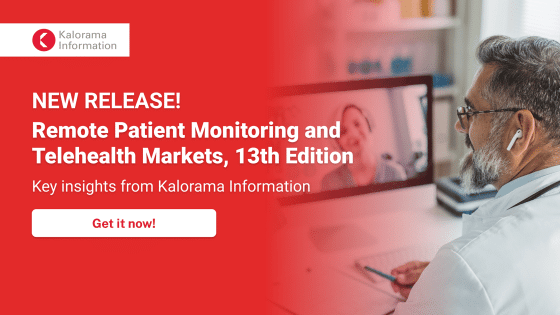
Telemedicine to address the growing need for mental health monitoring and intervention is one of several market opportunities that offer intriguing benefits over traditional office-based care. Also known as teletherapy (as well as telemental health, telehealth therapy, or telepsychiatry), this specific form of telemedicine is an area where interest has increased significantly, as barriers to treatment are threefold: lack of treatment resources; lack of adequate medical coverage; and embarrassment.
Globally, telemedicine is on the rise. Nearly $66 billion was spent on remote patient monitoring and telehealth equipment, devices, and services worldwide during 2023, up from $46 billion in 2018, reports leading medical market researcher Kalorama Information in the recent report, Remote Patient Monitoring and Telehealth Markets, 13th Edition. Growth is forecast through 2028.
Teletherapy, in particular, has emerged as a crucial service provided nationwide by United States schools in response to the escalating mental health challenges faced by American youth. An analysis by The Associated Press reveals that at least 16 out of the 20 largest U.S. public school districts now offer online therapy sessions, aiming to reach millions of students. In these districts alone, schools have entered into provider contracts exceeding $70 million.
Despite the inevitable concerns, educators highlight the effectiveness of teletherapy, especially as schools grapple with shortages of in-person practitioners. Teletherapy is proving beneficial for many students and is effectively addressing a significant need. Notably, it has simplified therapy access for rural schools and lower-income students. Schools facilitate student connections with online counselors, allowing them to engage during the school day or after hours from the comfort of their homes.
Mental Health Assessment Through Telemedicine
There have been several studies that examined the reliability and effectiveness of teletherapy compared with in-person care. It was found that teletherapy assessment and clinical outcomes were very similar to in-person care. Researchers are working to fill the gaps that may occur in teletherapy and understand for which circumstances or patient populations is teletherapy more effective than in-person care and vice versa.
For patients living in remote areas, obtaining adequate therapy can be difficult. Often, the patient requires a pre-assessment and a number of follow-up sessions. Several vendors now offer solutions with telemedicine systems, which can be applied to teletherapy.
Telehealth in Schools
Even beyond teletherapy, school-based telehealth is a growing trend in developed nations. The U.S. has been at the forefront of implementation with rapid expansion of programs in schools since 2017. There are several reasons for the growing trend including:
- School nurses are in a position to evaluate and notice health issues in students;
- Reduced potential for missed work and missed school days due to immediate available care;
- Less time spent traveling and missing school or work for in-person visits;
- Lower costs associated with telehealth compared to in-person care; and
- May provide an additional option for low-income families that find care inaccessible.
There are several current and potential applications to school-based telehealth including:
- Mental health,
- Acute care,
- Dentistry,
- Sports medicine,
- Counseling,
- Behavior health,
- Vaccination,
- Follow-up care.
There is also a growing practice for using telehealth in school-based programs to help monitor and manage youth with special needs. There are more than 15 million children alone in the U.S. with special health needs, and upwards of 60% do not have resources for continued coordinated and comprehensive care. Telehealth programs in schools may help address the shortfall through a partnership with pediatricians, school nurses, and families.
For more information on this and other telehealth trends, purchase Kalorama Information’s Remote Patient Monitoring and Telehealth Markets, 13th Edition.
About the Report
This report focuses on global patient monitoring and telehealth market numbers, with specific market coverage for countries such as the United States, Japan, China, Germany, the United Kingdom, Canada, France, Italy, Brazil, and Mexico. Additionally, regional coverage includes North America, Europe, the Middle East, Africa (EMEA), Asia Pacific, and Latin America. Sales figures are presented at the manufacturers’ level in U.S. dollars, offering a close comparison to retail levels in many instances.
Remote Patient Monitoring and Telehealth Markets, 13th Edition builds on its predecessor by providing comprehensive coverage in the consumer-grade segment and on-demand telehealth services. The consumer segment has emerged as a significant aspect of the industry in recent years, prompting professional-grade device manufacturers to adapt their product designs and marketing strategies to tap into this new growth opportunity. This shift has impacted various segments, including glucose monitors, heart rate monitors, fetal and pregnancy monitors, pulse oximeters, sleep apnea devices, weight monitoring devices, and other similar product offerings.
Click HERE for more information.
About Kalorama Information
Kalorama Information, part of Science and Medicine Group, is the leading publisher of market research in healthcare areas, including in vitro diagnostics (IVD), biotechnology, medical devices, and pharmaceuticals. Kalorama Information produces dozens of reports a year. The firm offers a Knowledge Center, which provides access to all published reports.
Kalorama Information’s studies feature independent primary research conducted by experienced analysts. Researchers build their market analysis independently from published databases, validating data with inside industry contacts and extensive secondary research, so you can have confidence that you’re getting your information from the most trusted source in the industry!
